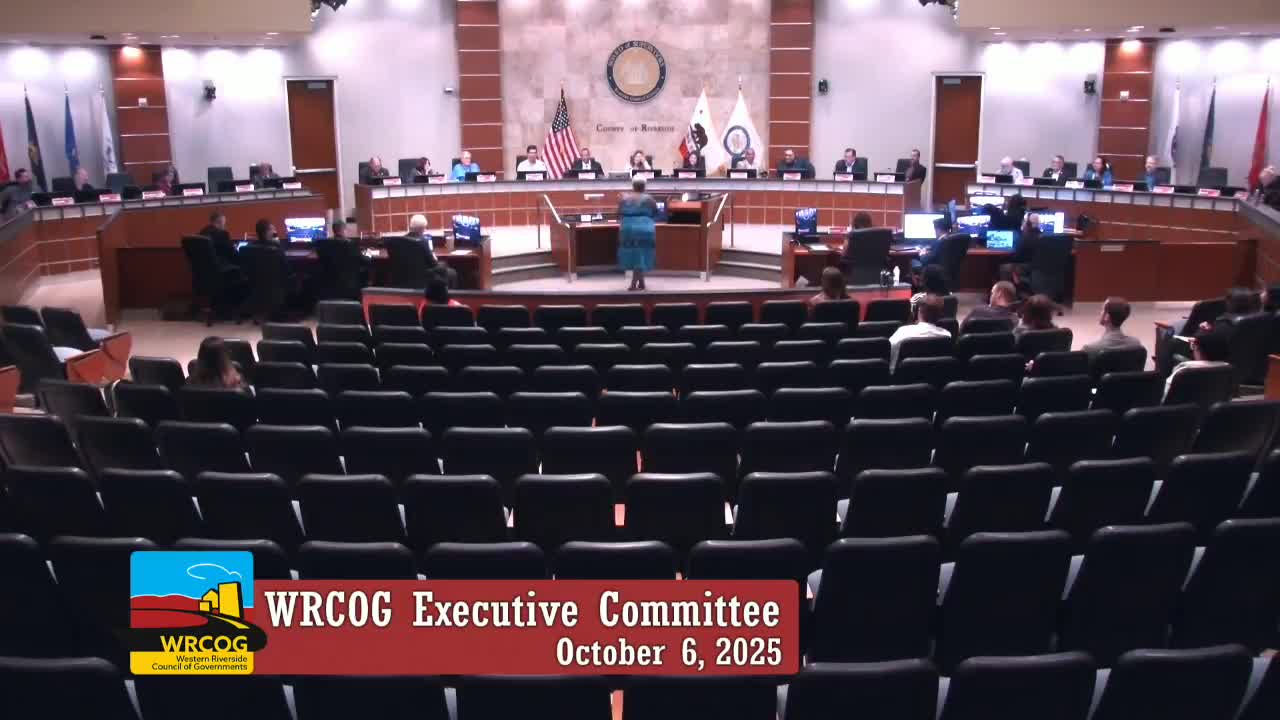SANDAG regional plan revision would add transit routes, bikeways and highway improvements; draft to be finalized in December
October 06, 2025 | Riverside County, California
This article was created by AI summarizing key points discussed. AI makes mistakes, so for full details and context, please refer to the video of the full meeting. Please report any errors so we can fix them. Report an error »

Colleen Wallace, representing SANDAG's Border Committee, summarized the draft 2025 regional plan and outreach results for the executive committee, saying the draft includes additions to the transit network, active-transportation projects and highway improvements and that SANDAG will finalize the plan and associated EIR for board action in December 2025.
Wallace said outreach included seven learning sessions (six in person and one virtual), 23 stakeholder presentations, 44 community pop-ups and targeted social-media advertising; public comment totaled 1,332 submissions, most (90%) submitted online. Major public themes were transit investment, bikeways and walkways, highways and roadways, housing and land use, climate and greenhouse gases, and Title VI (equity) concerns.
Key proposed transportation changes Wallace described include 59 new transit routes and upgrades to existing routes (including rural service), 36 neighborhood shuttle service areas, managed or complete lanes to improve traffic flow, safety and operational improvements to rural corridors and more than 730 miles of planned regional bikeways. She said major rural and corridor projects under consideration include SR 67 evacuation lanes, SR 76, SR 79 and SR 94 safety improvements, and Interstate 8 Willow Road interchange work.
Wallace provided SANDAG's estimated implementation cost categories and said the total was about $125 billion for highways, transit, flexible fleets, active transportation, local streets and roads, debt service, programs and policies. She said the plan's sustainable-communities strategy aims to direct 80% of future residents and employment growth to areas with existing or planned transportation options and that the plan's performance measures focus on travel-time reductions across modes, increased access to basic needs and safety improvements.
Wallace said SANDAG's board of directors is scheduled to adopt the final plan and EIR by Dec. 20, 2025, and encouraged regional partners to stay engaged in the final steps.
Wallace said outreach included seven learning sessions (six in person and one virtual), 23 stakeholder presentations, 44 community pop-ups and targeted social-media advertising; public comment totaled 1,332 submissions, most (90%) submitted online. Major public themes were transit investment, bikeways and walkways, highways and roadways, housing and land use, climate and greenhouse gases, and Title VI (equity) concerns.
Key proposed transportation changes Wallace described include 59 new transit routes and upgrades to existing routes (including rural service), 36 neighborhood shuttle service areas, managed or complete lanes to improve traffic flow, safety and operational improvements to rural corridors and more than 730 miles of planned regional bikeways. She said major rural and corridor projects under consideration include SR 67 evacuation lanes, SR 76, SR 79 and SR 94 safety improvements, and Interstate 8 Willow Road interchange work.
Wallace provided SANDAG's estimated implementation cost categories and said the total was about $125 billion for highways, transit, flexible fleets, active transportation, local streets and roads, debt service, programs and policies. She said the plan's sustainable-communities strategy aims to direct 80% of future residents and employment growth to areas with existing or planned transportation options and that the plan's performance measures focus on travel-time reductions across modes, increased access to basic needs and safety improvements.
Wallace said SANDAG's board of directors is scheduled to adopt the final plan and EIR by Dec. 20, 2025, and encouraged regional partners to stay engaged in the final steps.
View full meeting
This article is based on a recent meeting—watch the full video and explore the complete transcript for deeper insights into the discussion.
View full meeting
